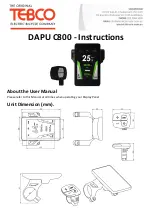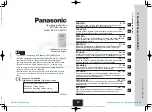
6
8.
Undo:
Undo
will take you out of the current menu and display the previous level of the menu path. Press
Undo
repeatedly to get back to a main menu or use it to erase data entered by mistake.
9.
Menu:
Displays the many setup and utilities functions such as tracking rate and user defined objects and many others.
10.
Scroll Keys:
Used to scroll up and down within any of the menu lists. A double arrow symbol on the right side of the
LCD indicates that the scroll keys can be used to view additional information.
11.
Rate:
Instantly changes the rate of speed of the motors when the direction buttons are pressed.
12.
RS-232 Jack
: Allows use with a computer and software programs for point and click slewing capability.
H
H
a
a
n
n
d
d
C
C
o
o
n
n
t
t
r
r
o
o
l
l
O
O
p
p
e
e
r
r
a
a
t
t
i
i
o
o
n
n
This section describes the basic hand control procedures needed to operate the NexStar. These procedures are grouped into
three categories: Alignment, Setup and Utilities. The alignment section deals with the initial telescope alignment as well as
finding objects in the sky; the setup section discusses changing parameters such as tracking mode and tracking rate; finally,
the last section reviews all of the utility functions such as adjusting the telescopes slew limits and backlash compensation.
A
A
l
l
i
i
g
g
n
n
m
m
e
e
n
n
t
t
P
P
r
r
o
o
c
c
e
e
d
d
u
u
r
r
e
e
In order for the NexStar to accurately point to objects in the sky, it must first be aligned with two known positions (stars) in
the sky. With this information, the telescope can create a model of the sky, which it uses to locate any object with known
coordinates.
A
A
u
u
t
t
o
o
-
-
A
A
l
l
i
i
g
g
n
n
Auto-Align is the easiest way to get your NexStar aligned and ready to observe. Even if you do not know a single star in the
sky, the NexStar will align itself by guiding the user through the alignment procedure by asking for basic information like
the date, time and location. The NexStar will then automatically choose two stars for alignment and roughly center the stars
in the field of view of the Star Pointer. Before the telescope is ready to be aligned, it should be set up in an outside location
with all accessories (eyepiece, diagonal and Star Pointer) attached and lens cover removed as described in the
Assembly
section of the manual.
1.
Once the NexStar is powered on the display will read
NexStar Ready
. Press
ENTER
to begin alignment.
The first time that the NexStar is used, it will request information to help identify the model of telescope. Once powered on,
the hand control will display the message
Select Model
Select Model
Select Model
Select Model
. Use the Up and Down menu keys (10) to scroll through the
different NexStar models. Press ENTER when your NexStar model is displayed on the hand control. This information will
be retained for future use and will not be displayed again. If for some reason the incorrect model was selected or you wish
to use your hand control on a different NexStar model, the
Select Model
utility feature allows you to re-select the proper
NexStar model from the displayed list (see
Select Model
later in this section).
2.
Use the Up and Down scroll keys to select
AutoAlign
if it is not already displayed
,
and press ENTER.
3.
The telescope will then ask you to use the direction keys (3) to level the telescope tube and point the front of the
telescope towards north. North can be found by finding the direction of the North Star (Polaris) or by using a compass.
You do not need to point at the North Star, only the north horizon. Alignment only needs to be approximate, however a
close alignment will make the auto alignment more accurate. Once the telescope is in the north and level position, press
ENTER.
4.
The hand control display will then ask for the following information:
Location
- The NexStar will display a list of cities to choose from. Choose the city from the database that is closest to
your current observing site. The city you choose will be remembered in the hand controls memory so that
it will be automatically displayed the next time an alignment is done. Alternatively, if you know the exact
longitude and latitude of your observing site, it can be entered directly into the hand control and
remembered for future use as well. To choose a location city:
Use the Up and Down scroll keys to choose between
City Database
and
Custom Site.
City Database
will allow
you to select the closest city to your observing site from a list of either international or U.S. location.
Custom Site
allows you to enter the exact longitude and latitude of your observing site. Select
City Database
and press
ENTER.
Summary of Contents for NexStar GT
Page 15: ...15 APPENDIX C MAPS OF TIME ZONES...
Page 16: ...16...


































